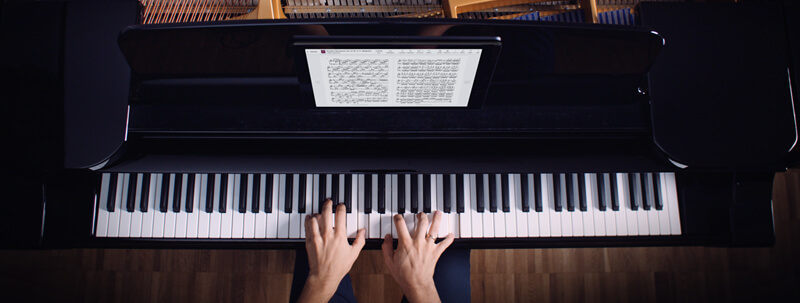How to Play the A-flat Major Scale on the Piano - Notes, Chords & Exercises
Jump to section
You get a fascinating chord poster + exclusive content!

What Are the Pitches and Notes of the A-flat Major Scale?
The A-flat Major scale starts on A flat and includes four flats: Ab, Bb, Db, and Eb. It uses the notes Ab-Bb-C-Db-Eb-F G-Ab. On the piano, you need to play four black keys: Ab, Bb, Db, and Eb. For all of the other keys, you can use the white keys.

How to Play the A-flat Major Scale With the Right Hand (Treble Clef)
On the piano, you can play the A-flat Major Scale going up (toward the higher notes), or coming down. This scale is played most conveniently with a bit of thumb-tucking:
- Play the following notes going up in the treble clef: Ab-Bb-C-Db-Eb-F-G-Ab. Start playing with your second finger on the Ab, and after you have played the Bb with your third finger, tuck your thumb to reach the C. Then continue up with the second and third finger on Db and Eb, respectively, then tuck the thumb again (!) to comfortably reach the F, and G, and end on Ab with your third finger.
- Play the following notes going down: Ab-G-F-Eb-Db-C-Bb-Ab. Go down inversing the exact way you have played coming up: Start playing with your third finger. After the thumb has played the F, tuck your third finger over the thumb to play the Eb, and continue until your first finger reaches the C, then tuck your third finger over again, to play the Bb, and finish with the second finger on Ab.

How to Play the A-flat Major scale with the left hand (bass clef)
Piano beginners may find it difficult to read and play the left hand. It is worth investing some time to really familiarize yourself with the notes of the A-flat Major scale in the bass clef, and learn how to read them in music scores.
The notes are the same in both clefs, treble, and bass, Ab-Bb-C-Db-Eb-F-G-Ab, but they look different:

The way you play the scale and the fingering is similar to how you play the right hand.
- Going up: Start with the third finger on Ab, then use the second finger to play the Bb, and the first finger to reach the C. Tuck your third finger over to reach the Db, then play the Eb with the second finger and the F with the first. Tuck your third finger again to play the G, and reach the Ab with the second finger.
- Coming down: Simply reverse what you've just done - start out on Ab with your second finger, play the G with the third, then tuck your thumb under to play the F. Continue down with the second and third finger, then tuck your first finger again to reach the C. Play the Bb with your second finger, and finish with your third finger on Ab.
The A-flat Major Key Signature
The key signature, located at the beginning of each line of a piece, lets you see which notes will be raised (#) or flattened (b) consistently throughout that piece.
If you spot this key signature below it is very likely that the piece is in Ab-Major (or it might be in F-minor, the related minor key. You can determine that by listening to the major/minor "mood" of the piece):

6 Exercises to Practice the A-flat Major Scale
Play one A-flat Major exercise after the other and only move on after having correctly played the previous exercise 5 times on your piano:
- Play the left hand up and down using a metronome and slowly increasing speed
- Play the right hand up and down using a metronome and slowly increasing speed
- Play both hands up and down using a metronome and slowly increasing speed - this one is NOT easy, so take your time!
- Play the left hand up starting from the lowest Ab to the highest, and down starting from the highest Ab to the lowest
- Play the right hand up starting from the lowest Ab to the highest, and down starting from the highest Ab to the lowest
- Play both hands up starting with the left hand on the lowest Ab and stopping when the right hand reaches the highest Ab, then play down to the starting position
Why you should exercise scales in general:
- To memorize a scale
- To practice dexterity and intonation (play all keys with even loudness. Beginners often play the notes they work with their stronger fingers much harder. Aim for an even tone)
- To be able to play the scale in time without hesitating to find your fingerings
- To be able to build chords and improvise
A-flat Major Chords on the Piano
A chord is constructed of three or more notes: The root note - the major third - the perfect fifth.
Briefly explained this tells us for A-flat Major:
- The basic A-flat Major chord consists of Ab-C-Eb.
- The first inversion is C-Eb-Ab.
- The second inversion is Eb-Ab-C.
To practice the A-flat Major chord and inversions, switch from the chord starting with the root note to the first, and the second inversion, starting slowly using a metronome, then increasing your tempo.
10 Popular Pieces in A-flat Major
- 1 Viva la Vida: Coldplay
- 2 Liebestraum, S. 541/3: Franz Liszt
- 3 Over The Rainbow: Harold Arlen
- 4 The Power of Love: Jennifer Rush
- 5 Only You (And You Alone): The Platters
- 6 Waltz A-flat Major, Op. 69 No. 1 (Valse de l'adieu): Frédéric Chopin
- 7 Somebody To Love: Queen
- 8 Maple Leaf Rag: Scott Joplin
- 9 Greensleeves: Anonymous
- 10 I Will Always Love You: Whitney Houston


